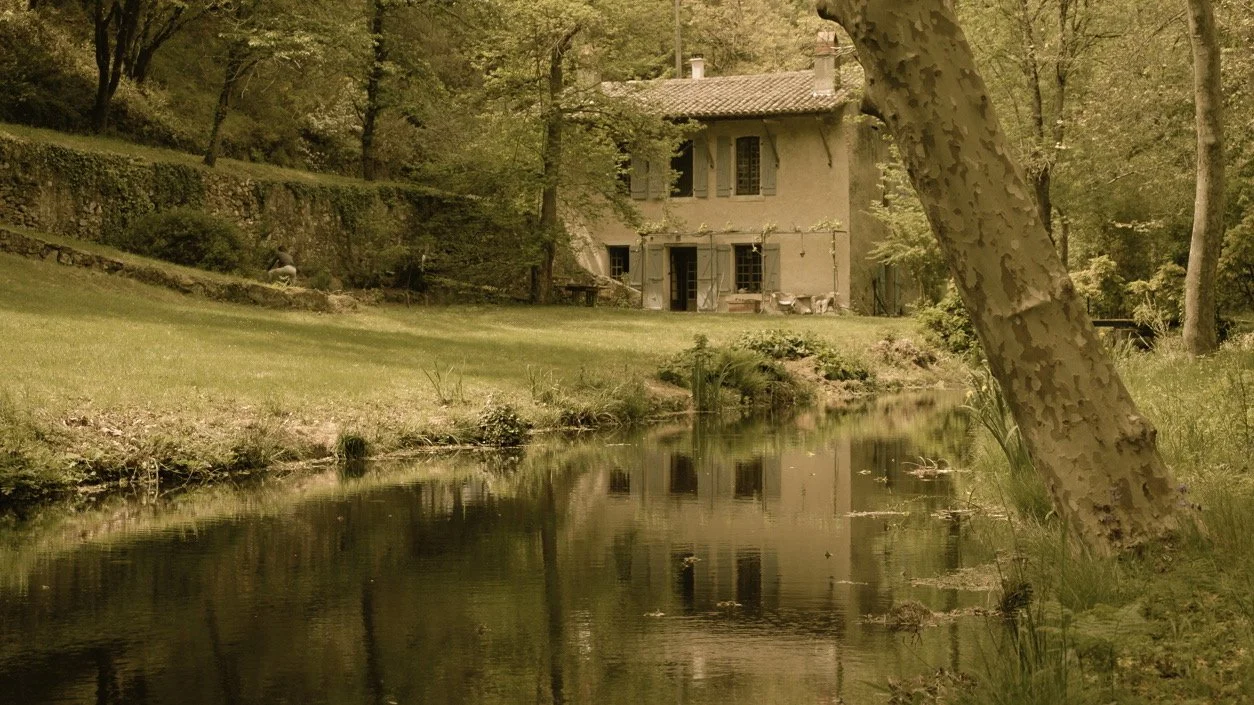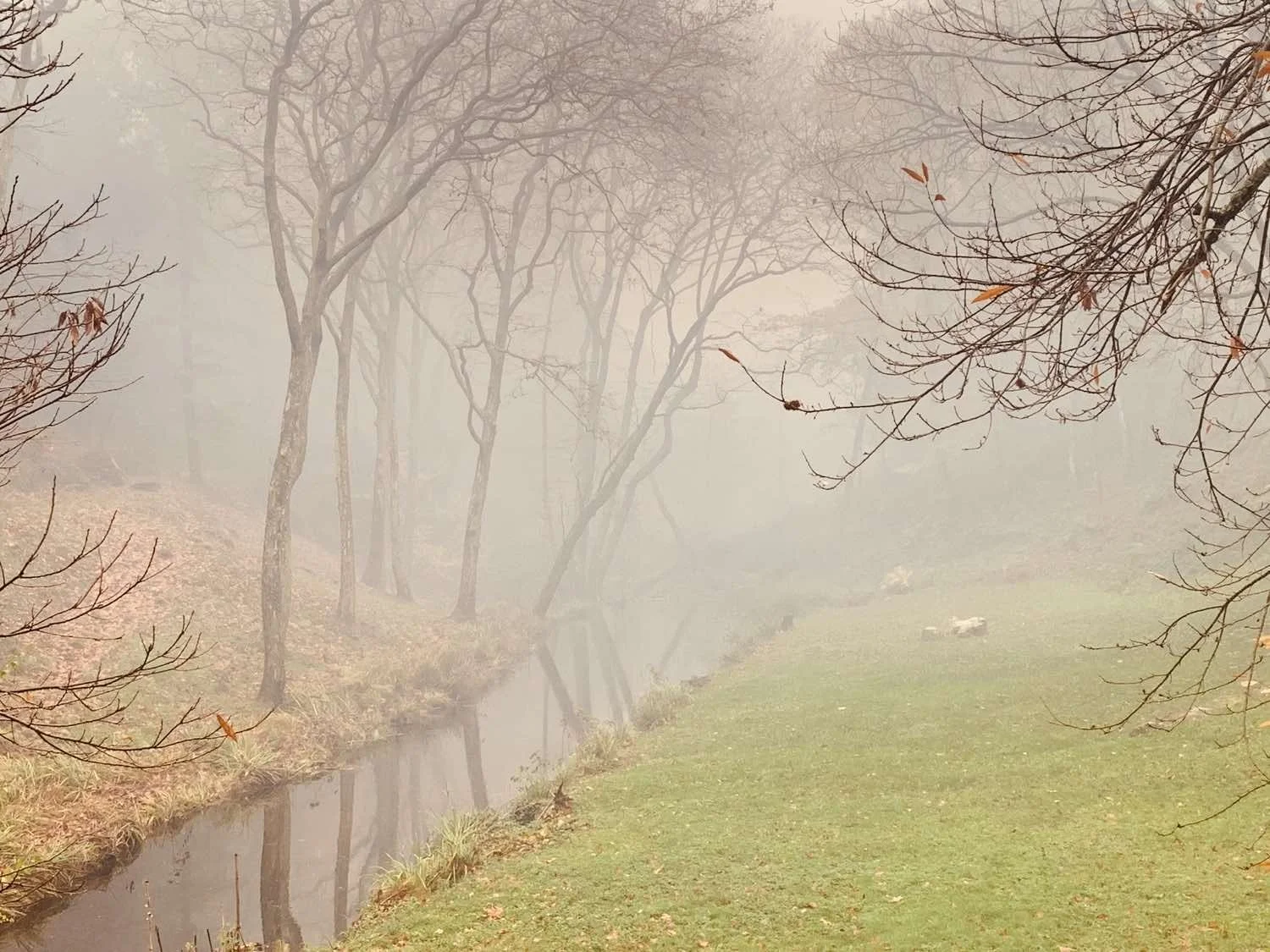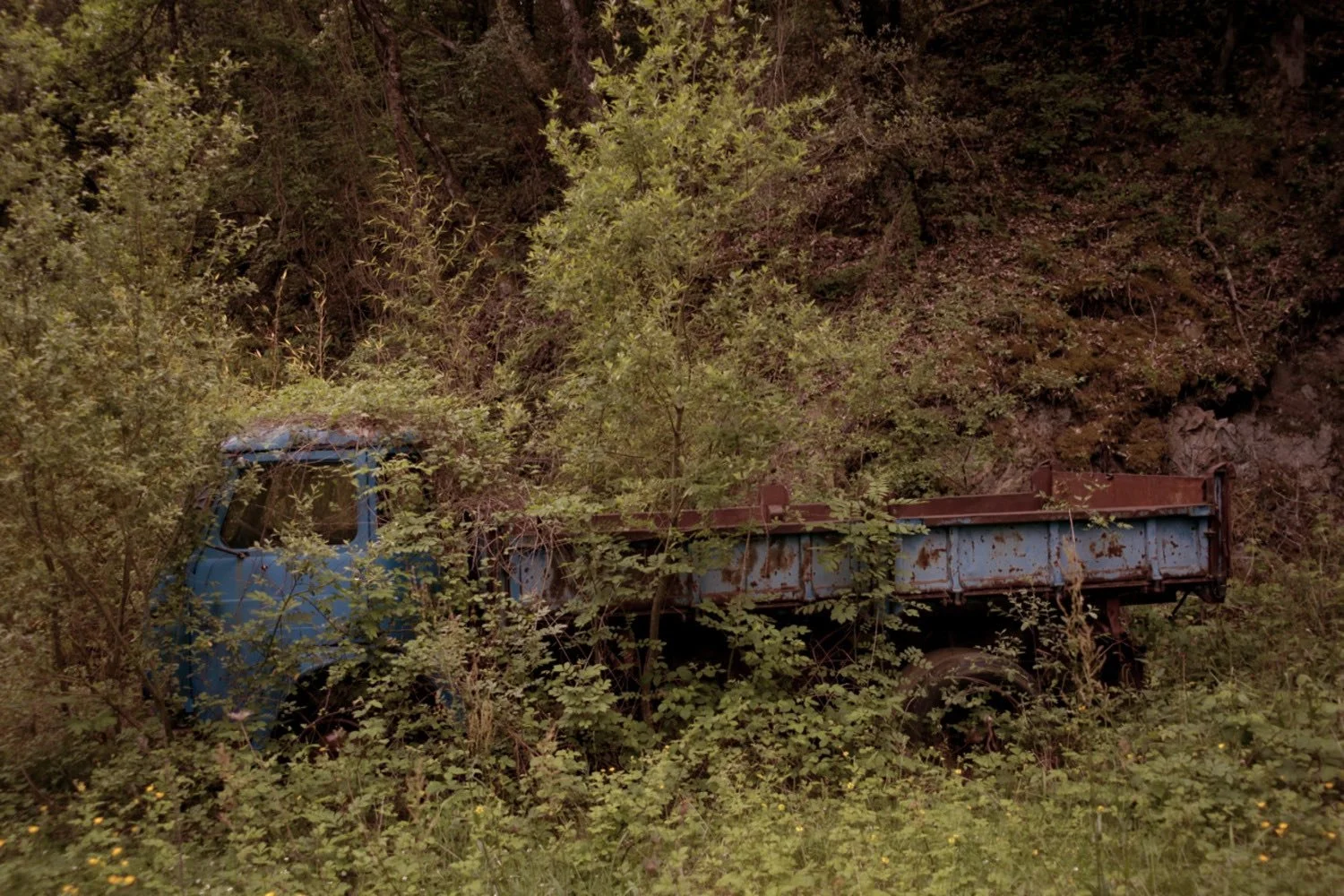FEBRUARY-MARCH 2024 - Part 4 - Le Foulon
Before arriving here in the Northeast of France to start set building, I spent three months in Paris rehearsing with the actors. Our rehearsal room, a small theatre in the 11th arrondissement, stood at the end of one of those particularly Parisian courtyards lined with well-tended containers of plants. In this instance of bamboo, acer and fatsia. A blackbird accompanied most of my journeys down its narrow length, flitting from branch to branch as I carried props or costumes back and forth It had been a mild winter but by the middle of January there were a few days of snow rendering the blackbird distinct against the bamboo bowed white and heavy. On the 18th of January I left the snow and headed south to meet Filip so that we could sign the purchase of the forested slope with its granite boulder.
-
The train slides down the Rhône Valley. To my right lies the Massif Central, weathered to softness in its old age; to my left, the Alps, pert and snow-capped with Mont Blanc visible in glimpses. Passing Valence, the landscape transforms into ridges and rocky clefts with spruce and olive. Cypress, umbrella pine and holm oak mark my arrival in the Mediterranean basin. The sun is reaching its modest, January peak, the snow of Paris is forgotten, and the landscape is bathed in a soft, translucid light. I drift between the view and my notebook. Time thickens…yes, but perhaps it is more accurate to say that like the earth’s crust, it folds.
-
I first came to our valley twenty two years ago, long after the Mécanique had closed its doors and fallen into ruin. Long too since the bare hillsides had started to re-populate with trees. I came because of two friends, Nicholas Wright and David Lan, who own a house, once an old fuller’s mill called Le Foulon. 150 metres down river of the Mécanique, it sits beside the river on the valley floor.
Pip, my first boyfriend and by then my first ex-boyfriend, had taken me to David’s birthday party by the Thames. I was working as a garden labourer in West London, having not long finished a nine-month stint as an actor in the long-running production of Priestley's An Inspector Calls. Nine months of tying a white bowtie around collars starched daily by the company dresser had given way to standing in damp jeans with a mug of milky tea in a client’s neglected garden. At the time, David ran the Young Vic Theatre in Waterloo and his boyfriend, Nicholas, had just opened a play he'd written called Vincent in Brixton at the National Theatre. Nicholas saw me walking up the stairs to the party. He turned to David, “And, who is that?” he asked. David replied that he had no idea.
And of course he didn’t. The following day I sent him a card: “I came to your party uninvited and left without saying goodbye,” it read, along with an earnest remark about a rainbow we’d seen across the Thames that day. When we subsequently met, David fixed me over the table, “What do you want?” he asked. Startled into an equal directness I replied that I was an actor and that he ran a theatre. “Hmm.”
A few months later, I was invited to a performance and then fundraising party at his theatre. I’m not sure what impression I gave, hovering as close to David as was reasonable while he tried to manage a room of important guests. Over-excited, entitled and nervous I suspect. Only a year out of drama school and with mud behind my fingernails after a day’s work, I had found myself at the centre of the world. There was Vanessa Redgrave! Is that Jude Law?
David, not sure what to do with me as he prepared to introduce a speech by Vanessa, delivered me to Nicholas. A week later, I was sat beside him at the National watching his play, Vincent in Brixton. I should be thinking now about Nicholas’ economy with words. His ability to transport and conjure without ornament.
In the beginning of that autumn, I knocked on their door in West London for my first day’s work as Nicholas’s literary assistant. He was writing his next play, an adaptation of Philip Pullman’s His Dark Materials. It was 2001 and I was living in East Finchley. It was also the beginning of a new chapter in my life. One that would lead me to this valley in the southern slopes of the Montagne Noire.
-
The train bends west towards Nîmes. South of me lies the wilder parts of the Camargue embraced by the two arms of the Rhône as it divides into the Grand and Petit Rhônes. Wild reeds and rice fields giving way to salt marches. I am picking through memories and adding them to my notebook, putting things in order. Between Montpellier and Sète, pink flamingos, indifferent to my anticipation, lower their bills into salty lagoons, sieving the silt of the marshes for morsels.
-
That’s right, I first came to the valley because of two friends, Nicholas and David who invited me to join them at their house there. I had not long before moved into their basement in Ladbroke Grove.
David collected me from the airport in an old, red Renault. As we turned north at Alzonne I was unaware we were tracing the path of the Lampy River past Raissac-sur-Lampy and Saint-Martin-Le-Vieil. I think I was only dimly conscious of a river at all. We rose up through Cenne-Monestiés and then followed the lane, bending past a farm until we forked right into a forest, then right again and descended - now on a rough lane of stones beneath a canopy of oak trees. “You might be disappointed,” he remarked just before the lane curved again and then opened into the valley.
It was August. The drive had taken us through harvested fields and biscuit-brown verges, but here I was enveloped in a brilliant, multihued green. A small valley hung between two, tree-covered slopes. Meadow-like grass became a lawn rolling up to what I took then to be the end of the valley and their house, Le Foulon, a simple, rectangular building of stone and lime with pale blue shutters and a vine growing over a pergola. A large chestnut tree stood in front. Flowing past the house, the Lampy river.
The lane carried us past the house and then hair-pined round to deliver us to the back door. I dropped my bag inside and walked across the kitchen to the double doors beneath the pergola, pulled that way by the light.
Standing beneath the pergola, I looked down the valley. To my right was the lane, sweeping into the valley and passed the chestnut tree and house with forest rising behind of holm and a mixture of deciduous oaks, densely understoried and curtained in places with rough bindweed. To my left, the river, fast as it approaches a small bridge, pressed to speed between boulders and the uprights of the bridge before relaxing into a wide, shallow bed lined on its left by a row of tall plane trees – the same row that borders the pasture upriver and which is visible in the photograph of the Mécanique taken all those years ago. The slope above them was dense and dark with mostly holm oak. Ahead of me, the river flowed towards a weir beneath a canopy of those plane trees, which seemed to encircle the end of the valley but in fact stepped over the river and continued as the valley curved to the right and out of sight so that the distance, only two hundred metres away, was made up of the left-hand slope of the valley wrapping around and seemingly closing the valley in a forested bowl.
I am plucked out of the valley by a pink graze of flamingos mirrored on the surface of a lagoon called the Étang de Thau as the train traces the narrow spit of land protecting a lagoon from the Gulf of Lion. The Canal du Midi tips into the lagoon here before entering the Mediterranean. The story of the canal and its construction is inextricably linked with that of the Lampy and the Mécanique. I make a note to find out more. But the train is now crossing the mouth of the Aude where the rain that runs beneath the plane trees in our valley joins the Mediterranean.
-
I have spent hours looking at that river, sat beside the old millwheel table beneath the pergola. The high sun of summer arcs from one side to the other, painting it vivid in greens and light. In autumn the sun makes iridescent the mist from the river, finding only brown and gold in the leaves. In winter, like a finger tracing the rim of a lid, it strokes the bare branches of the plane trees knocking drops of light into the river. Summer or winter, the light picks out the rising canopies of the forest like painted stage-cloths in an old-fashioned ballet.
It was that first summer that I decided to clean the rocks on the riverbed with a broom. I was 22 and as well-intentioned as I was vain. With lemon juice in my hair and a liberal coating of olive oil over my body to help me tan, I balanced on one rock while scrubbing the next. I used the broom as a pole-vault to jump forward, but my oil-slicked hands slid down the handle. The end shot into my armpit and lifted the shoulder clean out of its socket. It took three increasingly large doctors to relocate it as Nicholas sat in the hospital waiting room trying not to hear my screams.
Across the river, accessed by the small bridge that pinches the river to quickness, lies the once open pasture bordered by plane trees. Over the decades since the photographer took his photo it had become a jungle of ash saplings and brambles the height of a person. Over several years we cleared it, Nicholas, David, their old friend Michael and I, cutting and strimming, tugging up and burning until a wildflower meadow was established. Winding paths are cut through it each spring, guiding us as through a gallery of flowers. They pass two copses of ash trees then a large, lone crab apple before arriving finally in a small orchard we planted.
In the summer we drive to the barrage yet further upstream and swim in the reservoir, girding ourselves each time to jump from the barrage itself into the water. Nicholas and David’s godson, Balint, teaches me to dive from the rocks at the far side. Over these years I stop trying to find acting work and turn to directing, first plays and opera and then film. And I start writing.
The old, millwheel table under the pergola seats only two, side by side, looking down the valley. In winter, when the sun is low like a finger on the horizon, Nicholas and David eat their breakfast there whilst thumbing the news. On autumn evenings, Nicholas and I sip gin and tonic while one or other or both of us are writing, or not, because of the view which is like reading, which is like writing.
Since 2009, Filip and I take our turn there. We met in the summer that year when I was directing 120 primary school children in a production of Coleridge’s Rime of the Ancient Mariner beside the Thames. That autumn he visited Le Foulon for the first time. He descended the lane into the valley, bringing with him the effortless, sartorial style of Antwerp. I was standing in old cotton trousers held up by braces, giddy with excitement and making a show of raking the chestnuts and their prickly shells.
-
The lane curving down through the oak canopy and then straightening past the garden and the chestnut tree does not actually reach the valley floor. Rather it sits on a raised shelf on the hillside, held up by a three-meter retaining wall of stone. If, rather than branching right into the hairpin descent that brings you to the back of the house, you carry on a little, you reach a high metal gate with a “No Entry” sign. Beyond it, the lane continues, overgrown with weeds and brambles.
Standing in the emergent meadow you can barely see this part of the lane and its retaining wall. Cloaked in ivy, it blends into the forest above. At the foot of the wall are the boulders it was built on and, rushing past it, the river. From the furthest end of the meadow where the orchard sits, you can see the umbrella pine, leaning over that stone and timber-clad outbuilding of the Mécanique – “the ruin”. Covered in ivy and with its collapsed, wooden cladding, it is almost invisible through the trees that line the river. It was not only beyond the gate with its “No Entry” sign, for a while it seemed simply…beyond…buried and uninviting, like the forests on either side of the valley with their dark canopies of holm oaks and ragged curtains of thorny bindweed.
Except that summer days are long, and a “No Entry” sign brings out the twelve-year-old in me. So, as the overgrown pasture settled into meadow, my attention was lured past that sign and into that modest beyond. It was a year or two before the arrival of Filip. Crouching under the gate and then filleting my way through the brambles I came upon a clearing set into a cleft in the hillside. There I found a broken-down, blue truck rusting in a thicket of bamboo. I could pull the door open just enough to climb inside. The smell of disintegrating seat-leather, hot dashboard-plastic and trapped heat was overwhelming. An empty, long-ago clenched cigarette packet lay in the footwell.
Beyond it stood the ruin with a smell of goats and creosote and with the strewn detritus of failed enterprise – cables, broken glass, oil drums and cans. Crouched on the collapsed, wooden floor I could peer down into the basement where goats had once been wintered. Manure and decaying hay mingled with the smell of wood rot and petrol.
Behind the ruin, fringed in wild fig and tall ash trees, lay a long, rectangular crater, lined on three sides in cement and on one side with the steep, rocky slope of the hill. The floor was carpeted in grass and wildflowers. At the far end, a stone opening led to a dried-up watercourse. At this point I did not know it was once a building of four storeys, a cloth mill called the “Mécanique du Père”. I didn’t know that the watercourse was once a béal that turned a water wheel. I had heard that a decade or so earlier, a local man had filled the crater with water and attempted to run a trout farm. His frayed fishing nets were still lent against the walls of the ruin and buried beneath brambles were the small concrete tanks in which he had reared baby trout.
It was a place for exploring amongst the wild, enclosing greenery and for wondering whether I was too old to want to build a den. Unseen, I was twelve again, ferreting a similar terrain in the woods surrounding Marlborough College near where I grew up. There I had discovered a tall, concrete climbing wall hidden in the trees. Decorated in graffiti it was a temple to my lust for such neglected places. I would collect discarded shotgun cartridges strewn beside the near by shooting range, hoping to find an un-discharged one and I would search for torn-out page-three-girls, discharged in a similar fashion by the students between the bushes that grew beneath the musk of the sweet chestnuts. It was a kind of no-man’s land like that beside our house where the skirts of a holly tree would from time to time enshroud Simon, and I.
I had not long before made my first short film, an adaptation of Shakespeare’s sonnet, Let me not to the Marriage of True Minds. Both twelve years old and in my mid-twenties, with the potent scent of sweet chestnut here rendered to ripe fig, an idea for a longer film began to take hold.
-
The train glides west leaving the Mediterranean behind. The Pyrenees lie to my left, the Montagne Noire to my right. Somewhere around here the Fresquel meets the Aude. I will soon be home.
-
More pressingly, it is a particularly cold dawn here outside the farmhouse in the Northeast of France where I am turning back through the pages of my notebook and the notes I had made on the train last month. My fingers are growing as stubborn as the cobbles beneath my feet. I can hear the coffee machine inside which means the actors are awake. In an hour I will be meeting the town maintenance team to take delivery of a tree they felled in the scruffy corner of a park. Along with the blue-leafed branch, it will make up part of the set.


